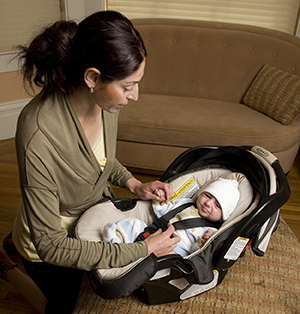Discharge Instructions: Taking Your Premature Baby Home from the NICU
Discharge Instructions: Taking Your Premature Baby Home from the NICU

Able to maintain a stable body temperature in an open crib
Breathing on their own
On complete breast or bottle feeding
Taking in enough calories to gain weight
What should I do before I bring my baby home?
Make sure you have a car seat appropriate for preemies. This means a rear-facing car seat with a 5-point harness that fits snugly. The car seat should be small enough to support and restrain the baby safely. You may be asked to bring your car seat to the hospital a few days before discharge so it can be checked to be sure it’s right for your infant. Babies who are born more than 3 weeks before their due date should have a period of testing their breathing, heart rate, and oxygen levels in the car seat before they leave the NICU. If special positioning is needed in the car seat, the nurses will show you how to do this.
Schedule a visit with your baby’s healthcare provider.
If your baby will be using any equipment at home, make sure to discuss it with your home healthcare specialist before discharge.
Take a class to learn infant CPR.
Special safety issues for preemies at home
Once they are ready to go home, preemies are much like other young babies. But you may need to be extra careful about certain things:
Protect your baby from infections. Breastfeeding or bottle feeding expressed milk provides more immune protection but doesn't prevent all infections. You should wash hands often with soap and water. So should anybody else who takes care of your baby. Limit contact with visitors, and avoid crowded public areas. If people in the household are ill, try to limit their contact with the baby.
Make your house and car no-smoking zones. Anybody in the household who smokes should quit. Visitors or household members who can’t or won’t quit should smoke only outside, away from doors and windows.
If your baby has an apnea monitor, make sure you can hear it from every room in the house.
Feel free to take your baby outside, but avoid long exposure to drafts or direct sunlight.
When to call the healthcare provider
Call the NICU if you have questions about the instructions you were given at discharge. Call your pediatrician or healthcare provider if your baby:
Has a fever (see Fever and children, below)
Has a temperature below 97.5°F (36.4°C)
Is not interested in feeding or is feeding poorly
Has fewer than 6 wet diapers per day
Is having trouble breathing and looks blue or pale
Is unusually irritable
Is listless and tired
Fever and children
Always use a digital thermometer to check your child’s temperature. Never use a mercury thermometer.
For infants and toddlers, be sure to use a rectal thermometer correctly. A rectal thermometer may accidentally poke a hole in (perforate) the rectum. It may also pass on germs from the stool. Always follow the product maker’s directions for proper use. If you don’t feel comfortable taking a rectal temperature, use another method. When you talk to your child’s healthcare provider, tell him or her which method you used to take your child’s temperature.
Here are guidelines for fever temperature. Ear temperatures aren’t accurate before 6 months of age. Don’t take an oral temperature until your child is at least 4 years old.
Infant under 3 months old:
Ask your child’s healthcare provider how you should take the temperature.
Rectal or forehead (temporal artery) temperature of 100.4°F (38°C) or higher, or as directed by the provider.
Armpit temperature of 99°F (37.2°C) or higher, or as directed by the provider.
Child age 3 to 36 months:
Rectal, forehead, or ear temperature of 102°F (38.9°C) or higher, or as directed by the provider.
Armpit (axillary) temperature of 101°F (38.3°C) or higher, or as directed by the provider.
Child of any age:
Repeated temperature of 104°F (40°C) or higher, or as directed by the provider.
Fever that lasts more than 24 hours in a child under 2 years old.
Updated:
September 30, 2017
Sources:
Discharge planning for high-risk newborns. UpToDate.
Reviewed By:
Freeborn, Donna, PhD, CNM, FNP,Image reviewed by StayWell art team.,Lee, Kimberly G., MD, MSc, IBCLC,Turley, Ray, BSN, MSN